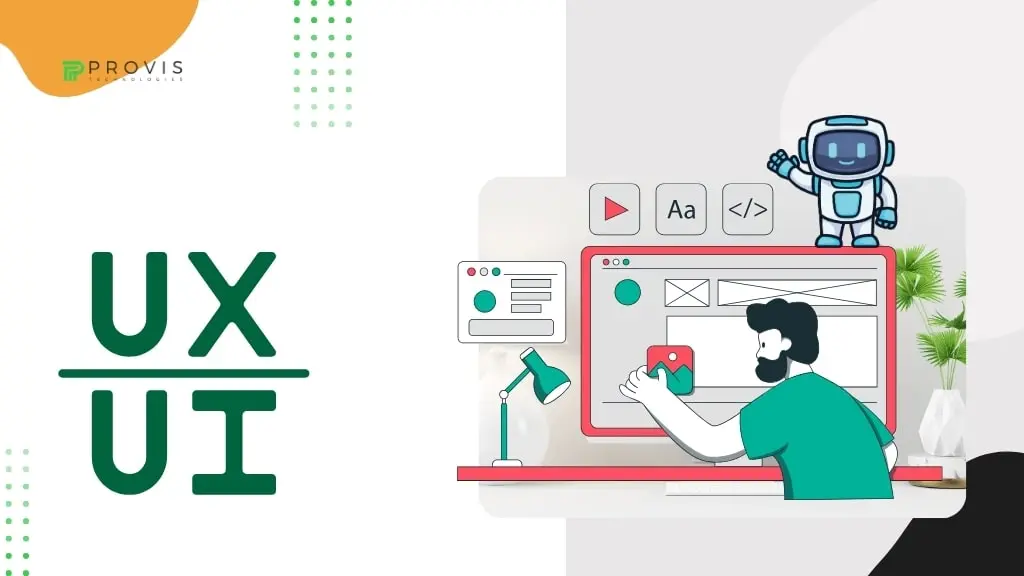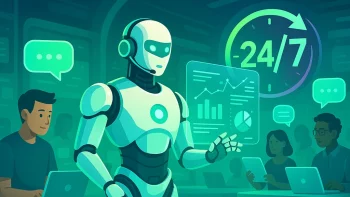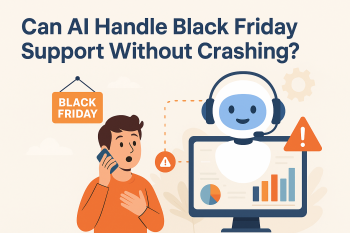Artificial Intelligence has been transforming various industries rapidly. It’s spreading like wildfire in every domain. These stats by NU prove it:
- 77% of all online businesses are either using or exploring AI.
- 83% claim that AI is a top priority in their plans.
- 9 out of 10 think that AI can give them a competitive edge.
- AI is expected to contribute around $15.7 trillion to the global economy by 2030.
- AI market size can possibly grow by 120% every year.
These figures are a testament to AI’s popularity. Today, we will talk about how AI affects UI/UX design. The user interfaces (UI) and user experiences (UX) are essential elements of a digital application. They are supposed to be functional and enjoyable to use. With AI’s capabilities, how designers approach AI UI/UX is bound to change significantly. Let’s know how!
How Will AI Affect the Design of UI/UX?
Since AI is getting into even those areas that were not thought it would go – it is poised to affect the design of UI/UX. AI can do much more than automate mundane tasks, enable personalized UX, and redefine the role of designers. The incorporation of AI integration services in UI/UX design & development is going to be really helpful for businesses.
Automation of Repetitive Tasks
One of the most immediate impacts of AI UI/UX design is the automation of repetitive tasks – you know that, right? Designers often spend hours & hours on tasks necessary but not creatively stimulating, such as resizing images, organizing content, or testing layouts. AI tools can take over these tasks to allow designers to focus more on creative & strategic aspects of their work.
AI-powered tools like Adobe Sensei and Sketch’s Auto-Layout feature can automatically adjust layouts based on content changes. This saves time and maintains consistency across different screen sizes. Automating these routine tasks can lend designers more time to innovate and refine the user experience.
Better Personalization
Personalization is needed for success today. It also helps create a compelling user experience for each individual user. AI has the potential to take personalization to the next level by analyzing vast amounts of user data and generating insights that can be used to tailor the UI/UX to unique preferences. Your users connect better with your business via personalization.
For instance, AI can analyze a user’s behavior, such as the type of content they interact with, the time they spend the most on your platform, and their navigation patterns. This data can then help to dynamically adjust the interface to better suit the user’s needs. If a user frequently uses a particular feature, the AI can make that feature more prominent in the interface. This will improve the user’s usability & satisfaction.
Moreover, AI integration can help create real-time adaptive interfaces based on the user’s behavior. This level of personalization was previously difficult to achieve but is now becoming more feasible with AI. As a result, users can enjoy a more intuitive experience – leading to higher engagement & retention rates.
Don’t Miss: How to Attract Visitors to Fall for Your Website?
Smarter Design Tools
AI is also making design tools more intelligent & intuitive. Traditional design tools require numerous manual inputs and expertise to create high-quality designs. However, AI-powered design tools are changing this by offering suggestions, automating design elements, and generating complete designs based on parameters.
Tools like Canva and Wix’s ADI (Artificial Design Intelligence) can automatically generate design templates based on the user’s input. These tools use AI to analyze the user’s preferences, the type of content they want to create, and other factors to generate a design that meets their needs. This simplifies the design process and makes it accessible to non-designers. Furthermore, AI can assist in creating more inclusive designs. It analyzes data on how different groups of users interact with a product and suggests design changes that make the interface accessible to more people. This ensures that the product is usable by a broader audience, which is becoming increasingly important in today’s rushy landscape.
Smoother User Testing
As you know, user testing is critical for the UI/UX design development process because it provides valuable feedback on how real users interact with your product. Traditionally, user testing involves recruiting participants, conducting tests, and analyzing the results – this is obviously time-consuming & expensive. However, AI can streamline this process by automating user testing. AI-driven tools can simulate user interactions and identify potential usability issues without the need for human testers. These tools can analyze user data, such as click patterns and navigation behavior, to predict how users interact with a new design.
Moreover, AI can facilitate A/B testing by quickly analyzing the performance of different design variations and identifying the most effective one. This allows designers to iterate and optimize their designs more rapidly, leading to better user experiences in a shorter time frame.
Must Know:– Key Principles of UI Design
Redefining the Role of Designers
As AI advances, it will inevitably redefine the role of UI/UX designers. However, we know AI automates many aspects of the design process – but it can never replace the creative and strategic thinking humans can do. Instead, AI will be a powerful tool that enhances the designer’s capabilities, but it surely is not the replacement.
Designers will increasingly focus on high-level tasks such as defining the overall user experience, setting design principles, and ensuring the product aligns with the brand’s identity and goals. They will also need to collaborate more closely with AI specialists and data scientists to leverage AI effectively in their work.
Designers will need to develop new skills to work with AI-powered tools. This includes learning to train AI models, interpret AI-generated insights, and integrate AI into the design process. As a result, the designer role will expand from focused on visual aesthetics to encompassing a broader range of responsibilities, including data analysis & AI integration.
Ethical Considerations
When AI integration services enter the UI/UX design & development domain fully – they may raise ethical considerations. As AI becomes more involved in the design process, there is a risk of creating biased or exclusionary designs if the AI is trained on unrepresentative data. Designers must remain vigilant and make sure the AI tools they use are trained on diverse and inclusive datasets.
Moreover, the increased use of personalization driven by AI raises concerns about user privacy. Collecting and analyzing large amounts of user data can lead to privacy issues if not handled properly. Designers must work closely with data protection experts to be sure that user data is collected, stored, and used in a way that respects privacy and complies with regulations.
Finally, there is the question of accountability. If an AI-driven design tool makes a mistake or creates a harmful user experience, who is responsible? Designers will need to take responsibility for the outputs of the AI tools they use and ensure that they are aligned with ethical design principles.
Related Blog: Healthcare Mobile App Design: Key Guidelines
Bottom Line
AI will definitely impact UI/UX design greatly to offer new opportunities for automation, personalization, and innovation. While AI can take over many routine tasks, it cannot replace the creativity and empathy that human designers bring to the process. Instead, AI will enhance the designer’s capabilities to allow them to focus on higher-level strategic work. As AI evolves, designers must adapt by developing new skills and embracing new tools. At the same time, they must be mindful of the ethical implications of using AI in design and ensure their work is inclusive, fair, and respectful of user privacy.
The future of UI/UX design is exciting, and AI will undoubtedly play a central role in shaping it. If you need any help with UI/UX design & development or AI integration services – connect with Provis Technologies. Provis Technologies offers top-level AI integration services for every sector and domain.
FAQs
How Will AI Affect the Design of UI/UX?
Largely, in many ways, most are mentioned above. The AI UI/UX design will change the game for this industry once fully incorporated.
Why does AI integration seem important in UI/UX?
Because there is a lot that can be done by AI, like automation. So, when we have AI and tasks for AI, why wouldn’t the human workforce focus on more creative tasks?
What if I want to get this done – AI UI/UX development?
Connect with Provis Technologies. Provis Technologies offers top-level AI integration services for every sector and domain.
Written By
Author's Picks
- Embracing the Future: Exploring Web Development Trends for 2023
- 24/10/2023
- How Artificial Intelligence is Revolutionizing Content Management Systems (CMS)
- 05/10/2024
- Data Privacy Laws and Their Impact on Web Development
- 18/09/2024
Categories
- AI for Startups
- AI in Web Development
- AI Integration
- AI Platforms
- AI Prompt
- AI Tools
- AI Trading Software
- Android App
- Android vs iOS Development
- Angular
- API
- API Development
- App
- app development
- App Idea
- App User Feedback
- Application
- Artificial Intelligence
- Audit Services
- Automotive Industry
- Awards and Recognition
- Business Consulting
- Business Website
- Chatbots
- CRM
- CRM for Financial Advisors
- Custom CRM
- Custom SaaS
- Custom Website
- Customer Service
- dashboard design
- Developing a Mobile App
- Digital Business
- E-commerce
- EMR Integration
- Finance
- Financial Advisors
- Financial Advisors
- GIT
- Health Insurance
- iOS App
- iOS App Development
- IoT Mobile App Development
- IoT Platforms
- IT Audit Services
- IT Consulting
- IT Strategies
- Java Development
- Laravel
- Lean Canvas
- Learning Management System
- Logistics Apps
- Mobile App Development
- MVP
- Native App
- News Aggregator Site
- OTT
- Outsourcing IT
- Payment Gateway
- predictive analysis
- Product Launch Strategy
- Progressive Web App (PWA)
- Prototype
- Recommender Systems
- Ruby
- SaaS
- SaaS Application
- SaaS Business
- SaaS Company
- SaaS Development
- SaaS Product
- SaaS Project
- Sales Funnel
- SEO
- Shopping Cart
- Software Development
- SSL and TLS
- Startup Checklist
- Technology
- Tetradic Color Scheme
- UI/UX Design Company
- Unit Testing
- User Flow
- User Testing
- Web Development
- Web Performance Optimization
- website Maintenance Services
- Website Migration Service
- Website Speed Optimization
- WooCommerce
- WordPress





